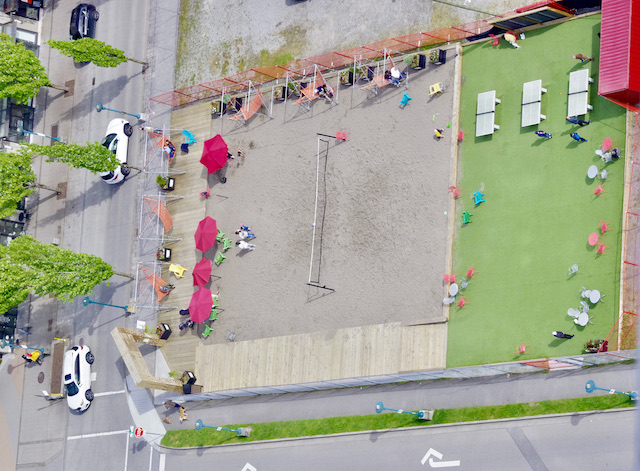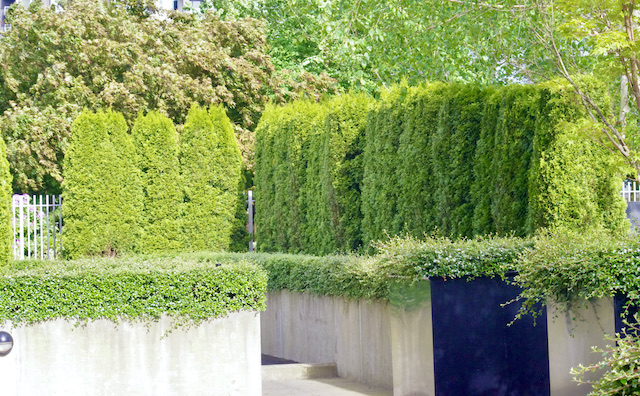
My favourite Michael Leunig cartoon, and one of his darkest.
I stand on the rooftop, 400 feet up, overlooking the city, the river, the forests and mountains beyond. I am filled with despair, with righteous indignation, with fear. I know this desolating civilization is collapsing, but I don’t want it to end in chaos, in violence, in suffering. But it increasingly looks as if that’s where we’re headed.
Of course I appreciate that all of these feelings are irrational. I do believe we are all doing our best, that we are conditioned to do what we do, and that we have no free will. The despair, anger and fear are quickly redirected inwards: How could I be so foolish as to not see this coming, to have expected a better outcome?

I look down over the rooftop’s stone wall at the little pop-up park that the city, and the mysterious property owner, have erected a block away, right beside my favourite local café. Since the birds are off busy building nests, sitting on eggs, and mobbing the occasional nest predator, my sanity today comes from watching the children in the park.
One of them, with great effort, climbs up on to one of the table tennis tables, in order to be able to watch two old men playing at the adjacent table. They’re really good at this — the child’s head goes back and forth quickly watching the ball, and clapping with glee whenever a point is scored, especially if it produces a spectacular or ungraceful move.
I am already starting to feel better.
A group of teens or young adults (hard to tell from 40 stories up) has just started an impromptu game of ‘beach’ volleyball. But the little kids seem oblivious, entranced by the sand and the colour and the excitement, and the volleyball players don’t seem to mind, considering the meandering kids to be natural obstacles to be avoided during play.
One child, barely able to walk, is kicking a soccer ball back and forth around the volleyball net posts, delighting in each pass under the net. Another is running furiously along the side of the ‘beach’ and then doing belly-flop dives into the sand. A third, on the other side of the volleyball game, plays happily with a pail and shovel beside the other volleyball post, under the watchful gaze of its mother, who is also rocking a baby carriage back and forth on the adjacent boardwalk.
Now a four-person game of ‘tag’ breaks out, and the laughter is infectious — the adults stop their conversations under the umbrellas and on the hammocks to watch. It occurs to me how different this is from the games these kids will soon play instead — organized sports and video games with winners and losers. But for now, these four little kids chase each other around the park, laughing non-stop, and when someone is tagged — everybody wins! There is a lot of falling down in the sand and giggling and wrestling and then pulling each other up and starting to play all over again.
And for some reason, watching this, I start to cry.

I make my way down to the 5th floor of the apartment, which opens onto a beautifully-landscaped common area. I’m hoping to catch sight of the pair of tiny house finches I first heard, and later saw, watching them flit among the strangely-manicured trees, from my view (shown above) from the treadmill in the gym I regularly use. They were evidently gathering twigs and grass for a nest.
I know a fair bit about house finches. They have a lovely, complex, joyous and evocative song, especially the courtship song, which is a kind of call-and-response (with the male, of course, singing louder and longer). This male has a particularly melodious song. I love the fact that his iconic red face and rump are rather paler and less spectacular than those of many house finches I’ve seen. Ornithologists say that female house finches clearly prefer the darkest red males, so I like to think that this little guy has made up for it in other ways. Maybe it’s his song, or his nest site.
As I watch for the finches (in vain, today) I think about human emotions, and how they seemingly differ from those of wild creatures. My sense is that wild (ie not in captivity) creatures, except in rare moments of acute stress, move back and forth between two states — equanimity and enthusiasm. I’ve seen this in birds, in deer, in cats and dogs, and suspect it’s more widely true. (Though I may have to use a different word for ‘enthusiasm’, since Euan just revealed that the word comes from the root meaning ‘in god’).
By contrast, humans seem to have a more complicated set of emotional states. As I think about it, they seem to fall into two types, that might be called instinctive emotional states and judgemental emotional states.
The instinctive states include equanimity and enthusiasm (though I see them mostly only in very young humans), and also the situational states of fear, rage/anger, and despair/grief/sorrow. My sense is that these ‘negative’ situational emotional states are fleeting in most wild creatures (until the danger/situation has passed), but are often chronic states in humans.
The judgemental states include the emotions that I think are probably unique to humans, and in particular to human ‘selves’ — anxiety, hatred, envy, jealousy, shame, guilt, longing, loneliness, despair, and, yes, love. They all require the making of, and belief in, an unprovable assessment, deep inside your head, of what has happened, is happening, or will happen.
[To those who protest and insist wild creatures love, I would certainly say they care (as the frequent crow mobbings of threatening predators attest), and I would agree that they can develop a conditioned attachment, but would refer you to the unashamedly animal-loving Melissa Holbrook Pierson’s book The Secret History of Kindness for the reasons why I don’t think wild creatures ‘love’, in the needy, defensive, sometimes violent and self-destructive ways that human beings ‘love’ another human. But that’s a subject for a later date.]
I guess what I’m thinking, at least for now, is that these ten (and I’m probably missing some) judgemental emotional states really do us a disservice. Especially if you believe, as I do, that we lack free will, these emotions contribute in no way to our health and fitness. I wonder if, in fact, they are all aspects of the ubiquitous human pathology of belief in a separate self, and we would be better off without them. Of course, we cannot undo the sickness that has caused them, so there is no comfort in this, if it is true.
Yes, yes, I know, I am thinking too much, and paying attention, with my senses, too little.

So I wander back, taking in the strange beauty of this ‘common’ area (but only for residents) with its carefully-pruned greenery surrounded by concrete. It’s even more lovely at night, when the soft lights come on. Even from the pool, it’s almost impossible to believe that you are in the midst of a city, so skilfully has the illusion of natural surroundings, obscuring the 20 nearby towers and sprawling malls, been woven.
Damn, this is no good. Now I’m starting to think about all the other things we hide from view to try to make our pathetic human civilization appear a little less ghastly than it is: the suppressed war and poverty and famine stories, the hundreds of millions of abused spouses and children hidden behind ‘privacy’ walls, the tens of billions of animals hobbled and confined in factory farms their whole lives, the atrocities that happen in old age homes, in back rooms, in prisons, in immigrant detention centres, in ‘education’ centres…
No. Won’t go there. There is no point. I look again at the forests, the mountains, the skies. The birds, building nests and singing astonishing songs. The dogs, greeting each other with wagging tails as they take their people on walks with ever-new smells.
And the little kids, playing the game of tag that nobody loses.





Immersing ourselves in nature is one of the few ways to temporarily escape from our terrible sickness caused by the “self” trick of the human brain. But in the end there is no real way to flee from the human condition.